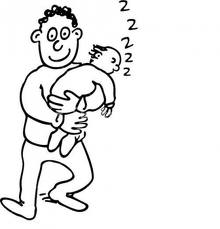If I can tailor the the words of Swedish playwright Henrik Ibsen to suit this important step: “You should never have your best trousers on when you go out to fight for freedom and truth… or help a woman through labour.”
The plays of Ibsen tell us a lot about giving birth, concerned as they are with stresses, inner pressure and self fulfillment. They have much in common, and so give Dads a peek through the curtain at what to expect on opening night. For example, the dialogue in both cases is a mixture of sentence fragments and exclamations, and what’s on view is potentially shocking to a conservative audience. However, the most obvious similarity between the two is structural – each is comprised of 3 ‘Acts’.
Act 1 – The Cervix Opens
The longest stage of labour, it sets the scene for the action and can itself be split up into three parts.
Scene 1.1 – Early Labour
The cervix thins out and opens up to a diameter of 3-4cm. Contractions can be gentle and more than 5 minutes apart. To avoid discomfort, encourage your partner to move around, take a shower/bath, and try different positions. For some women, early labour starts and stops, lasting for days. Others progress smoothly towards…
Scene 1.2 – Active Labour
The plot speeds up from this point on. Powerful contractions, coming every 3-4 min, rapidly open the cervix in this stage – but it can still last for hours. Employ relaxation techniques and back massage with your partner, and in between contractions give fluids and snacks to eat to keep her energy levels up. Also, cycle through the phrases “That’s it”, “Well done” and “Breathe”.
Scene 1.3 – Transition
A labouring woman’s waters will commonly break during transition, so change into your trackies. Covering the period from 8-10cm dilation, this can be an overwhelming stage for many women. Contractions come in double waves and your partner may become irrational – saying horrible things to you. She doesn’t really mean them. Still, write them down for later…
Interlude
After the transitional phase there may be a lull as your partner’s body gathers itself for the task of pushing baby out. You just might be able to nip out for a Choc-Top.
Act 2 – Down And Out
Now there’s a big enough gap down there, the uterus changes gear and starts pushing baby down into the birth canal. This is not a series of locks, but one of many euphemisms that refer to the vagina. Use gravity as an aid by helping your partner up.
Act 3 – Enter The Placenta
Once baby is out, smaller contractions deliver the placenta – a dinner-plate sized organ which has been nourishing your child over the last 9 months. You may want to have a look but there will probably be no resemblance.
THE END
There you have it. ‘Labour: A Three Act Play’. Now you’ve seen it, work with your partner to push your child out into the world – it’s good practice for when you have to do it again in 25 years time!

